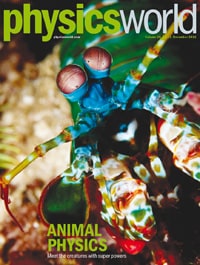By Matin Durrani

If you’re lucky enough to be a member of the Institute of Physics, you’ll have had access for almost a week now to the November 2012 issue of Physics World – either in print or through our digital issue, which you can access online or via our apps for smartphone and tablet devices.
But as the November issue is a special issue devoted to “animal physics”, we felt we wanted to share the issue more widely because we know how much everyone loves animals. So from today we’re making the issue available in free downloadable PDF form.
Of course, the PDF doesn’t have all the goodies of the digital issue, which this month includes some fantastic videos and audio of animals in action. But nevertheless the PDF is packed with a series of fascinating photos and features on a selection of animals all of which have some interesting physics involved in their daily lives.
So you can read how mosquitoes survive collisions with raindrops, find out why a certain species of hornet has an in-built solar cell, and discover why lions – strange as it may seem – roar like babies cry. You can also examine the age-old question of why zebras have stripes and ask whether cats and dogs drink in the same way.
Plus there is a series of seven fabulous images each devoted to a particular animal with some amazing physics powers. Download the PDF now.
Remember that if you want to read Physics World every month you can join the Institute of Physics as an IOPimember quickly and easily online by visiting the Institute’s website. IOPimember includes an annual digital subscription to Physics World.
And while I’m on animals, don’t forget to register – if you haven’t already – for our free online lecture on animal physics, which will be given by David Hu from the “laboratory for biolocomotion” at Georgia Institute of Technology at 3.00 p.m GMT on Thursday 8 November. You can register via this link.



